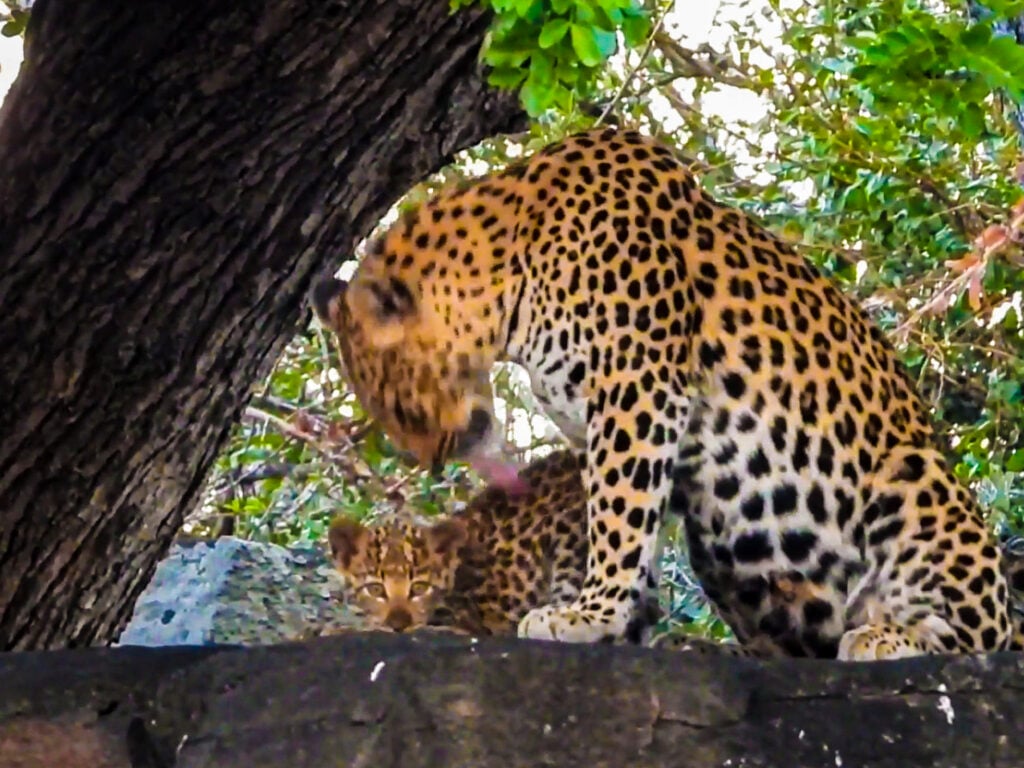
Watch the sighting here:
Alberto Scattolin from Matimba Bush Lodge sent this video to Latest Sightings. Unfortunately, we don’t have information as to where this delightful encounter occurred.
Getting comfortable
As Alberto’s video begins, a female leopard and her cub are seen on a rocky ledge. While the mother tries to settle into a comfortable position, her needy cub demands attention.

After a few moments, she settles down, but still, her cub circles her. Seeing his mum now settled, the cub appears to be looking for something.

The mother, meanwhile, looks like her patience is being tested.
But Ma, I’m hungry
It soon becomes apparent why the cubs is so fidgety. Brushing past her face, it makes a beeline for her belly. There, it latches onto one of her teats to suckle.

With that, the obviously exhausted mother attempts to get some shut-eye. However, the little cub’s sharp teeth make relaxing difficult. Consequently, she raises her head while the cub continues to feed greedily.

Having drunk its fill of nutritious milk, the cub takes the opportunity to explore its surroundings. Meanwhile, the mother grooms her belly to clean up any spilt milk.
Responsible parent
As the cub continues to get under her feet, the leopardess realises that she has neglected one of her parental duties.

With that, she licks her cub with her rough tongue, ensuring that it too is free of any spilt milk.

Get our Best Sightings as they Come in
I need a break
Possibly tired from a night on the prowl, the mother leopard again lies down on the rock ledge, this time facing away from Alberto and his camera.

Judging by the mischievous look on the cub’s face as it watches Alberto, the mother may have to go elsewhere for some peace and quiet.
Life cycle of a leopard
Leopards live alone and range across Africa, the Middle East and southern Asia. Highly adaptable, they live in a wide range of habitats, from deserts to rainforests.
After reaching sexual maturity at about 2.5 years of age, a female’s oestrous cycle lasts about 46 days, of which she will be in heat for a week. During this time, she will advertise her receptivity with scent markings and vocalisations.
After finding a suitable male, the pair mates repeatedly over several days before going their separate ways.
Gestation in leopards lasts between 90 and 105 days, after which she gives birth to a litter of 2 to 4 cubs. Helpless at birth, the cubs are born in a secluded den site where they will remain when the mother leaves to hunt. Infant mortality is quite high, with one of every two cubs dying in its first year.
The cubs will begin feeding on meat at roughly 9 weeks, and join the mother on hunts from around 12 weeks. From then on, they will hone their hunting skills. Initially, they will practice on the mother or sibling, before graduating to small live prey.
By one year, cubs may well survive independently, although they tend to stay with their mother for 18 months – 2 years. When she is ready to breed again, she leaves her cubs to continue the stealthy and solitary ways of their kind.
